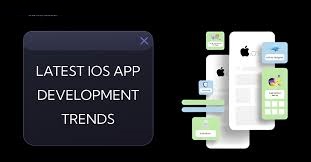 Automated Blog-to-Social Sharing – Publish Once. Appear Everywhere!
Automated Blog-to-Social Sharing – Publish Once. Appear Everywhere!
Future Mobile App Architecture for Business Success
Written by kathleen » Updated on: June 17th, 2025 280 views

The world of mobile app architecture is evolving rapidly. As businesses strive to deliver the best possible experiences, understanding these changes is crucial. Mobile app architecture is no longer just about building functional applications; it’s about creating scalable, secure, and user-friendly solutions. With new technologies and methodologies emerging, the future looks bright for mobile app development. In this post, we will explore key trends that will shape mobile app architecture and drive business success.
Shift Towards Microservices Architecture
Microservices architecture is transforming the way businesses develop mobile apps. By breaking down applications into smaller, independent services, this approach allows for greater flexibility and scalability. Each microservice can be developed, deployed, and maintained separately, reducing the complexity of the system. This modular design means that developers can update or add features without disrupting the entire app. It also enables faster response to user demands, ensuring a more agile development process. For businesses, this translates to a higher quality app that can adapt quickly to market changes. Embracing microservices architecture can lead to improved performance and customer satisfaction.
The Rise of Serverless Architecture
Serverless architecture is revolutionizing mobile app development. Imagine building apps without worrying about the underlying servers. That's the beauty of serverless. It allows developers to focus solely on writing code, while cloud providers manage the infrastructure. This approach can significantly cut costs since you only pay for the actual computing resources you use. No more over-provisioning servers to handle peak loads. Additionally, serverless platforms offer built-in scaling. As your app's user base grows, the infrastructure automatically adjusts to meet demand. This results in faster deployment and updates, enabling businesses to launch new features quickly. Embracing serverless architecture is a smart move for businesses aiming for efficiency and agility.
Enhanced Security Measures Through Zero Trust
In today’s digital landscape, security is paramount. The Zero Trust model is becoming a new standard in mobile app architecture. It operates on the principle that threats can come from anywhere, both inside and outside the organization. Instead of trusting any user or device by default, Zero Trust requires verification for every request. This strategy bolsters security by minimizing vulnerabilities and ensuring sensitive data stays protected. For businesses, implementing Zero Trust can significantly cut the risk of data breaches. It’s a proactive approach that keeps your app secure, maintaining user trust and safeguarding your reputation.
Good To Read :- Mobile App Architecture: An In-Depth Guide for 2024
Increased Use of Artificial Intelligence and Machine Learning
Artificial intelligence (AI) and machine learning (ML) are revolutionizing mobile apps. These technologies help apps become smarter and more intuitive. Imagine an app that learns from user behavior to offer personalized recommendations. Businesses can use AI and ML for better customer service, such as chatbots that handle inquiries 24/7.
Predictive analytics powered by ML can forecast trends, helping companies make informed decisions. This leads to more engaging user experiences and improved business efficiency. For example, AI-driven apps can provide tailored content, making users feel valued and understood. The integration of AI and ML in mobile app architecture is setting new standards for innovation and user satisfaction.
Cloud-Native Applications Taking Center Stage
Cloud-native applications are rapidly becoming a cornerstone of modern mobile app architecture. These apps are built specifically to leverage the full potential of cloud computing. They are designed for scalability, flexibility, and resilience, making them perfect for today's fast-paced business environment.
One of the main advantages of cloud-native applications is their ability to scale effortlessly. Whether your user base grows gradually or experiences sudden spikes, cloud-native apps can handle it all. This scalability ensures that your app performs well under any circumstances, keeping users happy and engaged.
Cloud-native apps also support continuous integration and continuous deployment (CI/CD) practices. This means that developers can roll out updates and new features quickly, without significant downtime. For businesses, this translates to staying competitive and responsive to market demands.
Another benefit is high availability. Cloud-native architectures are built to minimize downtime and ensure that your app is always accessible. This reliability is crucial for maintaining user trust and satisfaction.
Additionally, cloud-native applications can reduce operational costs. By utilizing cloud services, businesses can avoid the expenses associated with maintaining physical servers and infrastructure. You only pay for what you use, making it a cost-effective solution for many businesses.
Progressive Web Apps Gaining Ground
Progressive web apps (PWAs) are becoming increasingly popular in the world of mobile app development. They blend the best features of web and mobile apps, offering a seamless user experience. PWAs are designed to be fast, reliable, and can work offline, which is a huge advantage for users with intermittent internet access.
One of the biggest benefits for businesses is the cost-effectiveness of PWAs. Developing a single PWA can be more affordable than creating separate versions for iOS and Android. This streamlined approach reduces development time and simplifies maintenance, allowing companies to focus on enhancing features and user experience.
Another significant advantage is that PWAs provide a consistent experience across all devices. Whether a user is on a desktop, tablet, or smartphone, the app will function smoothly. This versatility helps businesses reach a broader audience without additional development effort.
PWAs also improve discoverability since they can be indexed by search engines. This means potential users can find your app through a simple web search, increasing visibility and engagement. Additionally, PWAs can be easily added to a user’s home screen, providing quick access just like a native app.
Must Read :- Top Mobile App Development Trends in 2024
Emphasis on User-Centric Design and Usability
The key to a successful mobile app lies in its design and usability. User-centric design puts the user at the heart of the development process. It’s about making apps that are intuitive, easy to navigate, and delightful to use. By focusing on the user's needs and preferences, businesses can create apps that truly resonate with their audience.
A major advantage of user-centric design is increased user retention. When users find an app easy to use, they are more likely to keep coming back. This drives engagement and builds loyalty, which are crucial for business success. Gathering user feedback is essential in this process. Listening to what users have to say can provide valuable insights into what works and what doesn’t.
Additionally, usability testing helps identify any hurdles users might face. This allows developers to make necessary adjustments, ensuring a smooth user experience. Accessibility is also a crucial aspect of user-centric design. Apps should be usable by everyone, including those with disabilities. Features like voice commands, larger text, and contrast options can make a big difference.
In a competitive market, standing out with a well-designed, user-friendly app can set a business apart. Prioritizing user-centric design leads to apps that not only meet but exceed user expectations. This approach is instrumental in driving both satisfaction and success.
Adoption of 5G Technology for Enhanced Performance
5G technology is a game-changer for mobile app architecture. With blazing fast speeds and ultra-low latency, 5G unlocks new possibilities for app performance. Imagine streaming high-quality video without buffering or enjoying real-time augmented reality experiences. Businesses can leverage 5G to deliver richer, more interactive content that keeps users engaged.
Lower latency means apps can respond almost instantly to user actions. This is especially crucial for gaming apps, where milliseconds can make a difference. Real-time data processing becomes more feasible, opening doors for advanced features like live data analytics.
Moreover, 5G supports a higher number of connected devices, ensuring smooth performance even during peak usage. This reliability is key for apps that handle a lot of traffic.
As 5G networks expand, apps that harness its capabilities will stand out. From immersive experiences to real-time interactions, 5G is set to redefine what's possible in mobile app development. Businesses that embrace this technology will have a significant edge, offering users faster, more reliable, and feature-packed apps.
Worried your app architecture isn't future-ready? Hire mobile app developers at Hidden Brains to ensure your success with the latest trends.
Conclusion
The future of mobile app architecture is packed with exciting possibilities. By adopting microservices and serverless architectures, businesses can develop apps that are both flexible and cost-effective. Enhanced security measures like Zero Trust ensure that user data remains protected, bolstering trust and reputation.
Artificial intelligence and machine learning add a layer of intelligence and personalization that can significantly enhance user experience. The rise of cloud-native applications offers unmatched scalability and resilience, making it easier for businesses to adapt to changing market conditions.
Progressive web apps provide a seamless and cost-effective alternative to traditional apps, allowing businesses to reach a broader audience without compromising on performance. User-centric design principles ensure that apps are not just functional but also enjoyable to use, driving engagement and retention.
Lastly, 5G technology promises to elevate app performance to new heights with faster speeds and lower latency, enabling richer and more interactive user experiences.
By staying ahead of these trends, businesses can build mobile apps that are not only cutting-edge but also aligned with user needs and market demands. Embracing these innovations will be key to thriving in the competitive world of mobile app development.
Note: IndiBlogHub features both user-submitted and editorial content. We do not verify third-party contributions. Read our Disclaimer and Privacy Policyfor details.
Copyright © 2019-2025 IndiBlogHub.com. All rights reserved. Hosted on DigitalOcean for fast, reliable performance.
















